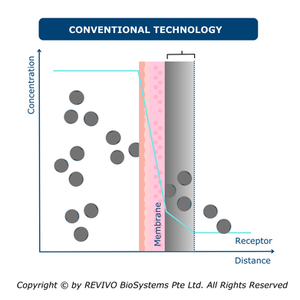
[July 2024 Edition]
Our unique 4D in vitro testing platform, ReleGO™ & REVex™, provides you with solutions to the limitations of the incumbent technology, enhancing accuracy and efficiency in your permeation studies.
Here’s how our advanced technology tackles the key challenges when it comes to permeation studies:
#1: Preventing air bubbles from disrupting your sampling process
In diffusion cells, it is not uncommon to see bubbles forming in the receptor chamber, right below the membrane. These bubbles disturb the concentration gradient, reduce the effective contact area, and compromise the sampling process. This introduces variability and inconsistency that will challenge the reproducibility and accuracy of the test results.
In contrast, the innovative design of bubble traps in our microfluidic chip, REVex™, ensures stable concentration gradients across the membrane, enhancing the accuracy of diffusion calculations. This leads to reliable permeation profiles and precise conclusions about membrane behavior. By eliminating air bubbles, we achieve consistent and uniform contact between the membrane and the receptor fluid, resulting in precise measurements of the membrane's permeation capabilities. In this way our solution prevents air bubbles from disrupting the sampling process, maintaining the reliability of analytical results. This eliminates variability and enhances the reproducibility of experimental setups across different studies.

#2: Reducing the dilution paradigm
With adjustable flow rates as low as 0.5 uL/min, ReleGO™ & REVex™ allow follow-on analysis of active and biochemical ingredients in tiny amounts due to the smaller volumes that flow under the skin tissue at each sampling interval.
Unlike traditional flow-through diffusion technology, ReleGO™ & REVex™ avoid high dilution of perfusates. This is achieved through eluates that are fractionally collected as small outflow volumes, allowing for the detection of compounds with smaller permeation rates.

#3: Preventing the buildup of Unstirred Water Layer (UWL)
In skin permeation studies, the Unstirred Water Layer (UWL) refers to a thin layer of water that remains stationary next to the skin membrane. This layer can create an additional barrier to the movement of substances, affecting the accuracy of permeation measurements.
Our microfluidic chip, REVex™, leverages narrow microfluidic channels which inherently promote laminar flow, reducing the likelihood of stagnant layers forming. Continuous flow of the receptor solution helps to maintain a consistent concentration gradient and prevents the build up of UWL by continuously renewing fluid in contact with the membrane.
#4: Overcoming the sink condition rule
Using current technologies to maintain sink conditions means that the receptor volume should be at least 10 times the donor volume. For a 10 mL donor volume, the receptor volume should be at least 100 mL to ensure steady-state diffusion and reliable measurement of permeation results.
The innovative design of the REVex™ chip changes this dynamic. By providing a consistent and laminar flow of the receptor fluid, REVex™ ensures steady-state diffusion, overcoming the traditional sink conditions. This delivers accurate and efficient in vitro permeation results, simplifying your experimental setup and improving reliability.
Ready to Transform Your Permeation Research? Our advanced microfluidic organ-on-chip platform, ReleGO™ & REVex™, will revolutionize the way you conduct safety, efficacy, and permeation studies of active ingredients and formulations.
We are present in 11 different regions. Click below to find your region and connect with our local representatives who can assist you with your specific needs and inquiries.
Upcoming Events
2024 PCHi Technology Summit | 21-22 August 2024 | Guangzhou, China
SCSS Suppliers Day 2024 | 27 - 30 August 2024 | Singapore
Cosmetic 360 | 16-17 October 2024 | Paris, France | Booth FA12
In-cosmetics Asia | 5-7 November, 2024 | BITEC, Bangkok, Thailand | Booth Y36







Comentarios